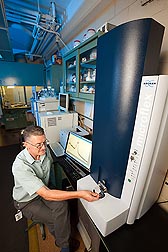This page has been archived and is being provided for reference purposes only. The page is no longer being updated, and therefore, links on the page may be invalid.
| Read the magazine story to find out more. |
|
|
|
|
Pine Tree Carbs May Help Improve Dogs' Digestive Tract Health
By Marcia WoodMay 31, 2013
Carbohydrates from an all-natural source—pine trees—may benefit dogs' digestive system health, according to collaborative studies by U.S. Department of Agriculture (USDA), university, and corporate scientists.
The carbs, predominantly a group known as "GGMOs" —short for galactoglucomannan oligosaccharides—make up to 70 percent of Previda, a dietary ingredient marketed as a fine-textured, light-tan powder to makers of pet food, aquaculture feed, and other animal nutrition products.
USDA Agricultural Research Service (ARS) chemist Neil P.J. Price began his studies of these fiber-rich carbs in 2007 under the terms of a cooperative agreement with a company called Temple-Inland. This Texas-based producer of wood products made from loblolly pine and other southern yellow pine trees approached ARS about potential new applications of the carbs, to augment their decades-old use as a cattle-feed ingredient.
GGMOs are a byproduct of treating wood chips that remain after trees are cut into lumber. Temple-Inland treats these chips with heat, high pressure, and hot water to separate them into cellulosic fiber—for making fiberboard products—and hemicellulosic carbs, such as the GGMOs that were the focus of Price's studies.
At the ARS National Center for Agricultural Utilization Research in Peoria, Ill., Price used proton magnetic resonance and other analytical techniques in studies that pointed to the carbs' potential as a pet-food ingredient.
The research led to today's powdered Previda formulation, and to collaborative studies directed by George C. Fahey, Jr., a University of Illinois emeritus professor of animal sciences. In that research, purified GGMOs from southern yellow pine were added, in place of dietary cellulose, to a high-quality kibble at the rate of 0.5 to 8 percent.
The kibble, or a "control" kibble containing no added GGMOs, was then fed to six healthy female dogs. Analyses of the dogs' fecal samples showed that increasing the percentage of pine GGMOs in the kibble was, in general, associated linearly with several significant indicators of a healthy lower digestive system, including an increase in populations of beneficial Bifidobacterium bacteria.
Hemicellulose extract, such as that in Previda, is listed as a safe ingredient in a "gold standard" registry maintained by the Association of American Feed Control Officials, a nonprofit organization that sets standards for the safety and quality of animal feed and pet food.
Price, Fahey, Temple-Inland chemist Anne C. Hopkins, former University of Illinois animal sciences graduate student Trevor A. Faber, and coinvestigators published their findings in the Journal of Agricultural and Food Chemistry in 2010 and 2011 and in the Journal of Animal Science in 2011.
Price’s studies are part of ongoing ARS investigations at Peoria and elsewhere to find new, renewable uses of plants. ARS is the USDA's principal intramural scientific research agency.

